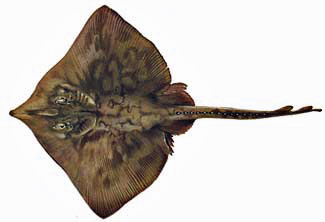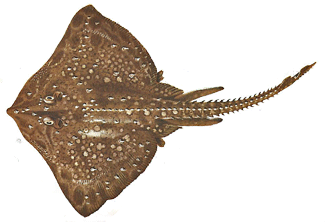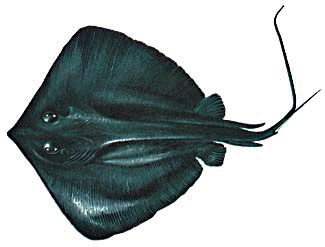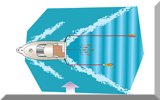- Home
- Fish Identification
- Skates and Rays
Skates and Rays May Look Alike, But They're Not...
They're cartilaginous fish, skates and rays. That is, they don't have a bony skeleton like true fish, but have one made of cartilage. Along with their close cousins - the sharks - rays and skates don't have a swim bladder, which makes skulking around on the seabed that much easier.
And there are other similarities with sharks too.
For instance, none of these types of fish have scales. Instead, they're covered with backward facing dermal denticles which gives them a coarse sandpaper-like skin.
And along with sharks, these fish have external gill openings, without the gill covers of bony fishes.
And they all sport relatively long snouts, with a transverse mouth some way back on the underside of the fish.
So What's the Difference Between Skates and Rays?
OK, getting back to the key differences between skates and rays...
- We've all seen these strange packages washed up along the shore line. Folklore has it that they're 'Mermaid's Purses' or sometimes 'Devil's Purses' but what they really are, are the egg cases of skate.
|
In these, the eggs of the female skate develop until the the young are mature enough to break out and stand a sporting chance of survival in nature's cruel world. |
Some types of sharks, lesser-spotted dogfish for one, similarly produce these egg cases.
But rays don't. Unlike the skate - which are oviparous (egglayers) - rays are viviparous, giving birth to live offspring which have developed within the body of the female.
- In comparison with a skate's tail, the tail of a skate is relatively slender. In the case of the stingray and the eagle ray it is particularly long - whip-like even - and comes equipped with a poisonous spine that can do you a deal of damage.
- Skates typically have a prominent dorsal fin but this is absent or much smaller in rays.
They're distinctly unadventurous fish, skates and rays, preferring to spend their days lurking camouflaged on the seabed. Once they find a habitat they like, they tend to stick around - long-distance swimming and seasonal migration just isn't their thing at all.
Common Skate
|
French ~ Pocheteau gris Italian ~ Moro Spanish ~ Noriega Portuguese ~ Raia-oirega German ~ Glattrochen This is the largest of all Atlantic skates, reaching a length of up to 2.5m maximum and weighing well over 100kg, although a fish of this size is extremely rare. |
Common Skate
|
The current British rod caught record Common Skate weighs in at 227lb and was caught off the Isle of Mull in the Inner Hebrides.
Adults live in depths of 100m to 500m, but juveniles favour shallower water.
The main food of the Common Skate includes marine worms, sandeels, crabs and flatfish.
Thornback Ray
|
French ~ Raie bouciée Italian ~ Razza spinosa Spanish ~ Raya de clavos Portuguese ~ Raia-lenga German ~ Keulen-stachel Also known a Roker, the Thornback Ray is something of an impostor, as it is really a skate. They reach a maximum length of 1.2m and favour muddy seabeds in depths of 20m to 100m, where they feed on small flatfish, crabs, prawns and sandeels. |
Thornback Ray
|
The British record for rod caught Thornback Ray currently stands at 31lb 7oz and was caught in Liverpool Bay.
Stingray
|
A ray that is well worth being able to identify quickly is the Stingray, as that poisonous spine can cause you a very painful wound. The spine can be up to 350mm long, and is shed several times during the fish's lifetime. Stingrays favour relatively shallow water, where they feed on small bottom living fish, crustaceans and molluscs. Stingrays favour relatively shallow water, where they feed on small bottom living fish, crustaceans and molluscs. |
Stingray
|
They seldom exceed 1.5m in length although specimens up to 2.5m long have been caught in nets.
They seem to be more tolerant of brackish water than other skates and rays, the British record of 72lb 2oz being caught in the River Blackwater estuary in Essex.
All artwork courtesy of Gyldendal Norsk Forlag
Fishing for Skates and Rays
There's nothing very technical about fishing for skates and rays - just put your bait - a fillet of fresh mackerel is as good as any - hard on the seabed, and wait.
If fishing from an anchored boat, use a running ledger rig and a hook snood of around 4 to 6 feet long and 40lb breaking strain - and a sharp, robust hook. Size 2/0 or 6/0 will be about right, depending on the size of the bait.
The fish will announce its presence by a couple of tentative knocks before it moves away with the bait, and that's the point at which you should strike.
Don't expect it to take off like a wahoo. Instead be ready for a tug of war - it won't give in easily!
Recent Articles
-
Sea Fishing Rods and Reels Must Be Compatible for a Balanced Outfit
Mar 08, 21 08:30 AM
A quality reel fitted to a quality rod doesn't necessarily make it a quality outfit. Your fishing rods and reels have to be properly matched if you're to get the best out of them, and here’s how -
Essential Lure Fishing Tips That All Saltwater Anglers Should Know
Mar 08, 21 04:51 AM
Which single lure fishing tip applies to trolling, jigging, baitcasting, spinning, fly fishing and any other branch of lure fishing? Well, it is the one at the top of this list -
Vital Jig Fishing Tips That You Really Cannot Afford To Miss!
Mar 07, 21 10:20 AM
Essential jig fishing tips to help you select the right lure for successful jig fishing, together with the techniques required to get the most out of your jig fishing outfit






















New! Comments
Have your say about what you've just read! Leave me a comment in the box below.